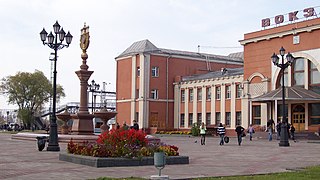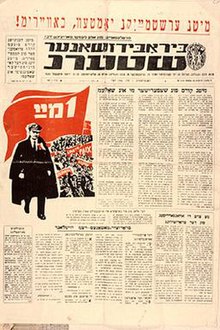
Yiddish is a West Germanic language historically spoken by Ashkenazi Jews. It originated in 9th century Central Europe, and provided the nascent Ashkenazi community with a vernacular based on High German fused with many elements taken from Hebrew and to some extent Aramaic. Most varieties of Yiddish include elements of Slavic languages and the vocabulary contains traces of Romance languages. Yiddish has traditionally been written using the Hebrew alphabet.

The Jewish Autonomous Oblast is a federal subject of Russia in the far east of the country, bordering Khabarovsk Krai and Amur Oblast in Russia and Heilongjiang province in China. Its administrative center is the town of Birobidzhan.

Birobidzhan, also spelt Birobijan, is a town and the administrative centre of the Jewish Autonomous Oblast, Russia, located on the Trans-Siberian Railway, near the China–Russia border.

Yiddishism is a cultural and linguistic movement which began among Jews in Eastern Europe during the latter part of the 19th century. Some of the leading founders of this movement were Mendele Moykher-Sforim (1836–1917), I. L. Peretz (1852–1915), and Sholem Aleichem (1859–1916). The Yiddishist movement gained popularity alongside the growth of the Jewish Labor Bund and other Jewish political movements, particularly in the Russian Empire and United States. The movement also fluctuated throughout the 20th and 21st century because of the revival of the Hebrew language and the negative associations with the Yiddish language.

DavidBergelson was a Yiddish language writer born in the Russian Empire. He lived for a time in Berlin, Germany, before moving to the Soviet Union following the Nazi rise to power in Germany. He was a victim of the post-war antisemitic "rootless cosmopolitan" campaign and one of those executed on the Night of the Murdered Poets.
Semyon (Shimen) Markovich Dimanshtein was a Soviet state official, publisher, and leading theorist of national issues in the USSR, and one of the founders of the Soviet Oriental studies. He was considered by the Soviet government to be a representative of Soviet Jews.
Obluchye is a town and the administrative center of Obluchensky District in the Jewish Autonomous Oblast, Russia, located on the Khingan River, 159 kilometers (99 mi) west of Birobidzhan, the administrative center of the autonomous oblast. Population: 7,959 (2021 Census); 9,379 (2010 Census); 11,069 (2002 Census); 12,016 (1989 Soviet census).
Mordechai Sheiner is an Israeli Orthodox rabbi associated with the Chabad Hasidic movement. Sheiner served as Chief Rabbi of Jewish Autonomous Oblast from 2002 to 2011.
The Birobidzhan Synagogue, officially the Freyd Community and Beit Menachem Synagogue in Birobidzhan, is a Chabad Jewish congregation and synagogue, located at 19 Lenina Street, in the city of Birobidzhan, in the capital of the Jewish Autonomous Oblast, in Russia.
Lev Grigorievich Toitman was a soldier in World War II. Toitman is known for the "foundation and revival of the local Jewish community" in Birobidzhan.
Birofeld is a village (selo) in Birobidzhansky District of the Jewish Autonomous Oblast, Russia. It is an early Jewish settlement, which was founded in 1928 when a large collective farm was established in the area. In 2003, a Jewish Book Festival took place here. In 2006, Chief Rabbi of the Jewish Autonomous Oblast, Mordechai Scheiner, visited Birofeld with the Jewish community of Birobidzhan. As of 2007, some of the original Jewish settlers still lived here.
Yiddishkeit is a Russian documentary television show concerning the subject of Yiddishkeit. Since 2005, when the show had begun taking its current format, it is edited by Tatyana Kadinskaya, directed by Natalya Kaper and filmed by Oleg Veksler. The former Chief Rabbi of the Jewish Autonomous Oblast, Mordechai Scheiner, and his wife, Esther Scheiner, were often guests who hosted parts of the show. Before 2005, various programs related to Yiddish and Jewish subjects were regularly broadcast by the local television without a specific name.
The history of the Jews in the Jewish Autonomous Oblast (JAO), Russia, began with the early settlements of 1928.

Emmanuil Genrikhovich Kazakevich was a Soviet author, poet and playwright of Jewish extraction, writing in Russian and Yiddish.

Birobidzhansky District is an administrative and municipal district (raion), one of the five in the Jewish Autonomous Oblast, Russia. It is located in the center of the autonomous oblast. The area of the district is 4,442.56 square kilometers (1,715.28 sq mi). Its administrative center is the town of Birobidzhan. Population: 11,907 ; 13,018 (2002 Census); 15,437 (1989 Soviet census).

Obluchensky District is an administrative and municipal district (raion), one of the five in the Jewish Autonomous Oblast, Russia. It is located in the north, east, and center of the autonomous oblast. The area of the district is 13,300 square kilometers (5,100 sq mi). Its administrative center is the town of Obluchye. Population: 29,035 ; 36,515 (2002 Census); 43,062 (1989 Soviet census). The population of Obluchye accounts for 32.3% of the district's total population.

Smidovichsky District is an administrative and municipal district (raion), one of the five in the Jewish Autonomous Oblast, Russia. It is located in the east of the autonomous oblast and borders Khabarovsk Krai in the north and east, China in the south, and Birobidzhansky District in the west. The area of the district is 5,900 square kilometers (2,300 sq mi). Its administrative center is the urban locality of Smidovich. As of the 2010 Census, the total population of the district was 28,165, with the population of Smidovich accounting for 18.2% of that number.
Yoel Matveyev, born in 1976, is a Yiddish poet, writer and journalist from Leningrad, USSR with background in computer programming. He taught himself Yiddish at high school age and started writing Yiddish poetry as a teenager. Matveyev is also a Russian writer and poet.
The region of Siberia has been home to Jews since the late 18th century, although Jewish communities did not exist in large part until after 1861, when Tsar Alexander II lifted the restrictions of his father, Tsar Nikolai I regarding Jews in the Pale of Settlement.









